Nyheter
Why Are DEXs the Undisputed Game-Changer of Modern Digital Finance?
Publicerad
5 månader sedanden
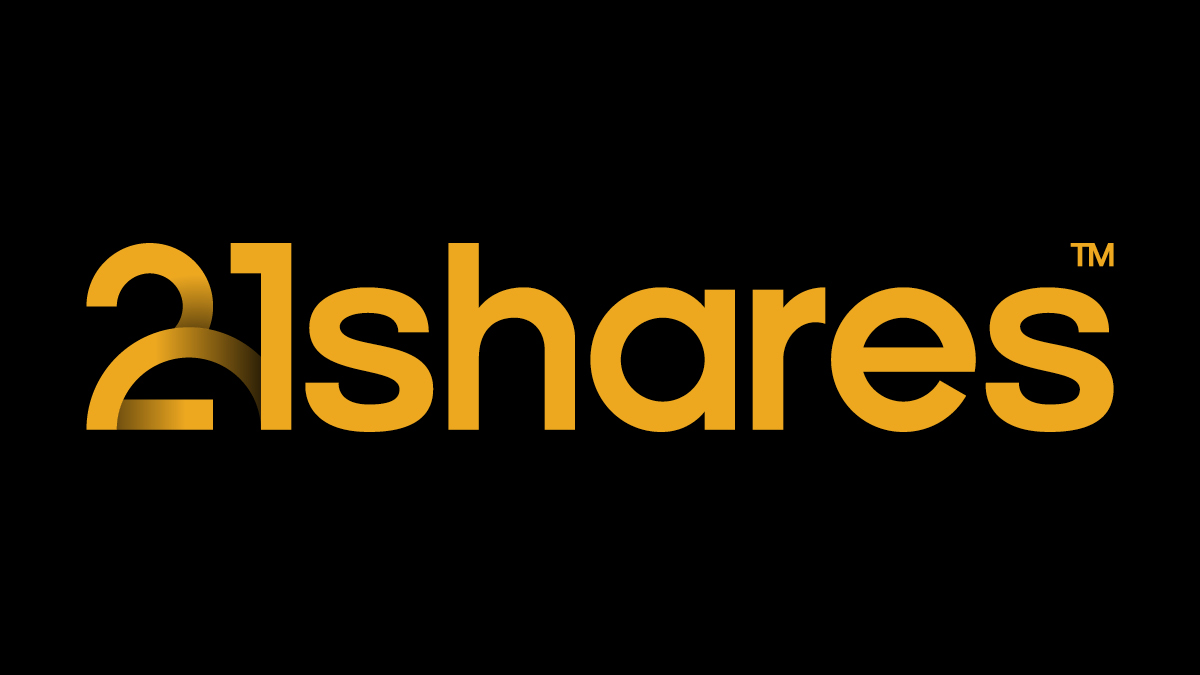
The decentralized finance (DeFi) sector is poised for explosive growth, with estimates projecting at least an $80B valuation by the end of 2025. This remarkable trajectory is fueled by a confluence of factors, including favorable regulatory shifts and the pivotal role of decentralized exchanges (DEXs) in driving market trends. At the heart of the DeFi landscape are four key exchanges that exemplify the sector’s dynamism and potential:
- Uniswap: The industry titan with multi-chain dominance
- Aerodrome: Base network’s powerhouse
- Raydium: Solana’s DeFi cornerstone
- Jupiter: The innovative aggregator reshaping Solana’s ecosystem
Why focus on these exchanges now? The DeFi sector is at a critical juncture:
• Imminent protocol upgrades promise to reshape market dynamics.
• Institutional participation is surging, driven by regulatory clarity.
• The Total Value Locked (TVL) in DeFi is expected to surpass $250B by year-end.
• DEXs are playing a crucial role in emerging trends, including the rise of memecoins, AI agents and tokenized real-world assets.
As we delve into these four pivotal exchanges, we’ll uncover the technological advancements, market strategies, and regulatory adaptations that are set to define DeFi’s trajectory in 2025 and beyond.
For starters, what are Decentralized Exchanges (DEXs)?
DEXs are non-custodial exchanges empowering users to trade assets directly via self-executing smart contracts, bypassing traditional intermediaries. By linking non-custodial wallets like MetaMask and Phantom, traders retain full control of their funds while swapping tokens across different blockchains. Instead of centralized order books, DEXs leverage automated market makers (AMMs)—algorithmic liquidity pools that set prices and enable anyone to contribute capital, democratizing market access for both users and liquidity providers. As seen below, the ratio of volume between decentralized vs. centralized venues has reached its highest level to date.
Figure 1: Decentralized to Centralized Exchange Spot Volumes

Source: 21Shares, TheBlock
Why are DEXs important?
DEXs dismantle financial gatekeepers, democratizing access through unstoppable, open-source protocols that fuel permissionless innovation. Unlike centralized giants like Mt. Gox or Bitfinex—whose catastrophic hacks exposed systemic fragility—DEXs are immune to single-point failures due to the decentralized nature of their underlying networks. Their censorship-resistant design ensures no entity can freeze assets or halt transactions. For example, the SEC sent a Wells notice to Uniswap Labs alleging they’re facilitating the trading of unregistered securities. While the foundation removed the tokens from its front end, the underlying smart contracts remained accessible on Ethereum. This meant that users could still interact with these tokens through alternative front-ends or by directly engaging with underlying smart contracts. This reinforces that while regulators target surface-level interfaces, the core infrastructure remains immutable—a testament to DeFi’s immutable foundational promise.
Having said that, aggregators also play an important role. Just as brokerage platforms consolidate fragmented liquidity across centralized exchanges, DEX aggregators in crypto fulfill a similar role. These tools optimize trade execution by intelligently routing orders, reducing slippage and costs by 2-5%. Working symbiotically with DEXs like Uniswap, aggregators drive 20-35% of DEX volume, creating a win-win ecosystem: DEXs gain increased activity, while aggregators thrive on consolidated liquidity. This collaboration transforms isolated pools into a cohesive financial network.
Why are we talking about them now?
For one, DeFi ranks among the highest revenue-generating sectors in the crypto ecosystem, as seen in Figure 2. This stems from DeFi’s early maturity and its strong Product-Market Fit due to its vital role in enabling access to emerging sectors.
Figure 2: Breakdown of the top 20 revenue-generating protocols, categorized by sectors, over the last year.
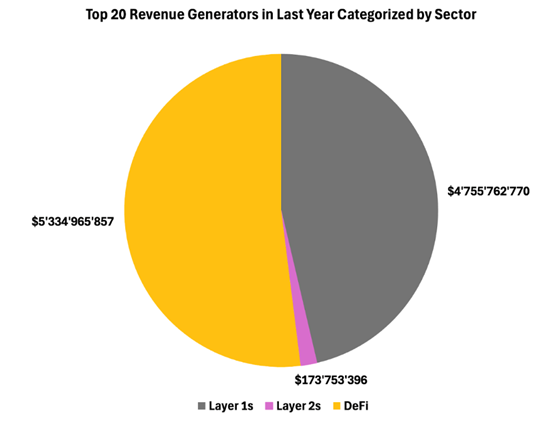
Source: 21Shares, TokenTerminal
Specifically, DEXs dominate blockchain activity as the primary gas consumers, with platforms like Uniswap and Raydium consistently ranking as top spenders across the landscape, as seen in Figure 3. Furthermore, exchanges have a symbiotic relationship with stablecoins: over half of Tether’s on-chain transactions originate from trading, creating a self-reinforcing cycle where Tether liquidity fuels DEX volume. At the same time, DEX demand solidifies Tether’s dominance. By driving 60-75% of on-chain activity through token swaps, stablecoin demand, and dApp liquidity provision, exchanges act as a foundational access point for the crypto ecosystem.
Figure 3: Top 10 Gas Spenders in Last Year
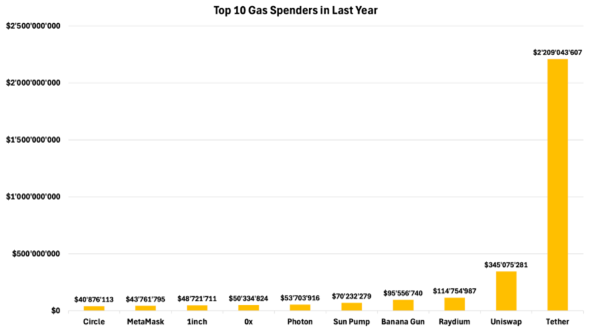
Source: 21Shares, TokenTerminal
In a sense, DEXs not only drive their own ecosystem but also generate a significant portion of the demand for the underlying blockchains they operate on. However, they can capture even more value and strengthen the investment case for their native tokens by positioning them as the gas token for their dApp. Given the self-reinforcing ecosystem and user loop they create, it becomes increasingly logical for DEXs to evolve into their own app-chains—allowing them to fully internalize transaction fees, optimize performance, and enhance user experience while maintaining sovereignty over their liquidity and trading infrastructure.
We are seeing this starting to materialize, both with Uniswap’s Unichain, which we wrote an entire previous newsletter on, and Jupiter’s Jupnet. The latter is a new omnichain network aiming to unify liquidity across multiple blockchains into one platform, creating a decentralized ledger that enhances usability for both users and developers. Jupnet envisions a future where a single account can seamlessly access all chains, currencies, and commodities—referred to as the ”1A3C” vision. This approach is designed to simplify blockchain interactions while empowering new innovations in cross-chain liquidity and usability.
The evolution of Uniswap and Jupiter into application-specific chains represents a strategic shift in the DeFi landscape driven by similar motivations. Both protocols aim to optimize their ecosystems by vertically integrating their operations. Uniswap’s upcoming Unichain and Jupiter’s cross-chain network are designed to significantly reduce fees, enhance trading speeds, and consolidate fragmented liquidity across multiple chains. In addition, it also creates new revenue streams by capturing MEV —estimated at over $400M annually—that previously leaked to third parties. By internalizing these value streams, both protocols transform from mere liquidity providers into self-sustaining trading ecosystems while building defensible moats against competitors
Beyond this strategic shift, Uniswap is also setting itself up for success with the release of v4, which was just deployed this week. The latest upgrade enhances v3’s efficiency with optimizable adapters that enable custom logic during swaps, liquidity actions, or fee collection. This modular design supports advanced features like limit orders, dynamic fees, and automated liquidity management without core protocol changes. Traders and liquidity providers benefit from reduced costs and flexible fee structures that optimize value distribution.
DEX Memecoin Frenzy
The surge in non-custodial infrastructure adoption has been significantly propelled by memecoins, offering an accessible gateway for newcomers to the crypto ecosystem, especially as these tokens are often unavailable on centralized exchanges during their initial launch. This trend has been a major catalyst for DEX growth over the past year, peaking with Trump’s memecoin launch. A prime example is Raydium, Solana’s largest DEX, where memecoin trading dominates activity. In the last 24 hours, memecoins represented 7 of the top 10 most traded tokens on the platform, accounting for over 30% of its total volume. Expanding this view, 41 of the top 50 traded tokens were memecoins, contributing to more than 50% of Raydium’s daily trading volume. These statistics underscore the pivotal role of memecoin speculation in driving DEX activity and liquidity in decentralized markets.
Figure 4: Raydium 24-Hour Spot Trading Volume

Source: 21Shares, Coingecko
$TRUMP, World Liberty Financial (WLFI) Convergence, What’s Next?
The Trump ecosystem appears poised to expand its crypto footprint. Following their DeFi lending platform (WLF), a Trump-branded DEX could emerge as the logical next step—transforming TRUMP from a memecoin into the cornerstone of a self-sustaining DeFi network. Despite ranking 40th in market cap, TRUMP already claims a top-10 trading volume spot, signaling robust demand. A dedicated DEX would amplify this activity while unlocking fee-based revenue, solidifying Trump’s crypto influence through an integrated swap-lend-earn ecosystem.
Looking ahead, a Trump Layer 2 or appchain could elevate this vision. By designating TRUMP as the network’s native gas token, the ecosystem could internalize transaction fees, enhance scalability, and deepen token utility. Such a move would transcend memecoin status, potentially reshaping how public figures monetize digital influence and the overall perception of these tokens.
Having established the critical role of DEXs, let’s now explore the key factors that set them apart and their key value propositions:
Total Value Locked serves as DeFi’s primary metric for measuring capital deployed across protocols. Initially, Uniswap dominated this space by capitalizing on Ethereum’s first-mover advantage and network effects, reaching a peak TVL of $10B. Despite severe market fluctuations during recent crypto winters, DEX TVL remained stable – demonstrating DeFi’s market maturity and sustainable product-market fit.
Figure 5: Total Value Locked Across Major DEXs

Source: 21Shares, DeFiLlama
The competitive landscape has shifted significantly with new entrants challenging Ethereum’s dominance. Aerodrome leveraged Coinbase’s Base network integration to streamline user onboarding, while Solana’s low-cost infrastructure fueled growth of protocols like Raydium and Jupiter, which now collectively hold over $5B in TVL. These developments reduced Uniswap’s market share from near-total dominance to roughly 50% of the combined TVL held by these three emerging rivals. This redistribution highlights DeFi’s evolution into a multi-chain ecosystem where scalability and user experience increasingly dictate platforms’ success.
Daily active users follow a similar trend. Uniswap, benefiting from Ethereum’s ecosystem, once dominated but Solana-based apps, especially Raydium, surged. By late last year, Raydium captured over 80% of daily active users, driven by memecoin trading’s retail appeal.
Figure 6: Daily Active Users Across Major DEXs

Figure 7: Total Volume Across Major DEXs

Source: 21Shares, TokenTerminal, Artemis
Transaction counts also highlight the rapid growth of Solana-based platforms, particularly Raydium, driven by speculative trading and low costs. As shown in Figure 8, Raydium reached a peak of over 25M transactions in a single day, more than double its other competitors, showcasing its dominance in the current DEX landscape.
Figure 8: Total Transaction Count Across Major DEXs
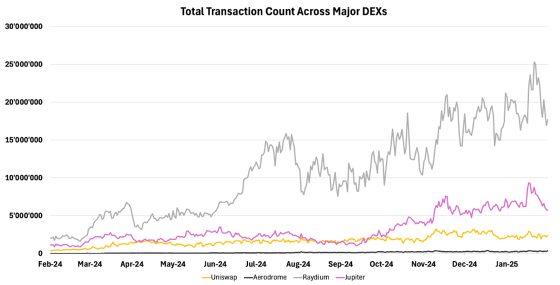
Source: 21Shares, Token Terminal, Dune
Figure 9 highlights that Raydium’s significant activity translates into equally notable revenue generation, making nearly $30M in revenue the weekend ahead of the inauguration. Meanwhile, Aerodrome generates substantial revenue due to the vote-escrow mechanism which is explored in a later section.
Figure 9: Total Revenue Generated
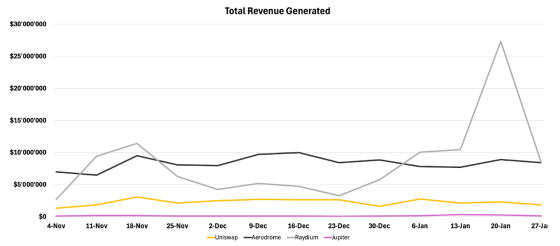
Source: 21Shares, TokenTerminal, Dune
For the technically curious, the following section delves deep into the intricacies that distinguish these DEXs.
Figure 10: Comparing the Different DEX Platforms
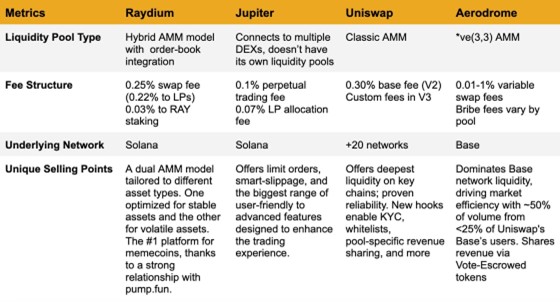
Source: 21Shares
The main differentiating feature amongst DEXs is how they operate their liquidity models. For example, Raydium’s Hybrid AMM model combines Concentrated Liquidity Market Maker (CLMM) with Central Limit Order Book (CLOB), offering both customizable liquidity ranges and traditional order matching. This model provides flexibility for traders and liquidity providers. Alternatively, Uniswap’s Classic AMM, maintains liquidity across all price points, ensuring continuous liquidity. However, this model may be less capital efficient and more rigid.
Finally, Aerodrome’s *ve(3,3) AMM, inspired by Curve Finance, introduces vote-escrowed tokens and bribes to incentivize liquidity provision. This model allows token holders to lock their tokens for voting rights and elevated rewards, potentially creating a more engaged and stickier liquidity base. As such, each model offers a unique balance between simplicity, capital efficiency, and user incentives.
To summarize, these are the key distinctions between all 4 models:
• Raydium offers customizable liquidity ranges and traditional order matching.
• Jupiter is an aggregator that lacks its own liquidity engine. However, it offers centralized exchange-level features like limit orders and dynamic slippage calculator,upgrading the typical DEX user-experience.
• Uniswap V3 pioneered concentrated liquidity, enabling roughly 4000x capital efficiency vs V2 in stablecoin pairs.
• Aerodrome uses Curve-style vote-escrow tokens (veAERO) with bribes directing 73% of revenue.
Having identified the differences between the platforms’ technologies, let’s compare the valuation of their respective tokens:
Figure 11: DEXs’ Tokens Valuation Metrics

Source: 21Shares, TokenTerminal
*Jupiter’s revenue here only accounts for its spot market activity, although the bulk of its activity actually comes from its derivatives platform, that’s why it has such a seemingly unfavorable market cap / revenue ratio.
As seen, Aerodrome stands out as a remarkably undervalued token compared to its peers, driven by its impressive revenue generation and dominance on the Base network. Despite operating on a single chain and capturing less than 25% of Uniswap’s user base, Aerodrome’s performance underscores the power of strong product-market fit. Its success, particularly when compared to multi-chain platforms like Uniswap, highlights the potential for focused, chain-specific exchanges. In terms of Market Cap to TVL, Uniswap and Raydium’s low ratio suggest undervaluation, reflecting high capital efficiency and stronger usage. However, relative valuation is just one factor to consider, as these protocols are at varying stages of maturity. The evolving DeFi landscape suggests a future where multiple specialized exchanges can thrive simultaneously, each carving out its niche in the broader ecosystem.
All in all, DeFi emerges as a 2025 standout sector, fueled by regulatory tailwinds and accelerating institutional adoption of on-chain infrastructure. At its core, DEXs like Uniswap and Jupiter are evolving into critical infrastructure, leveraging innovations such as Unichain and Jupnet to achieve institutional-grade scalability while pioneering app-chain architectures. As the DEX/CEX volume ratio reaches record highs just shy of 40%, these platforms are uniquely positioned to capitalize on the migration to decentralized markets. Their growing emphasis on user-aligned tokenomics—where revenue-sharing mechanisms transform governance tokens into yield-generating assets—creates a compelling value proposition for investors navigating this new era of value accrual in DeFi.
What’s happening this week?
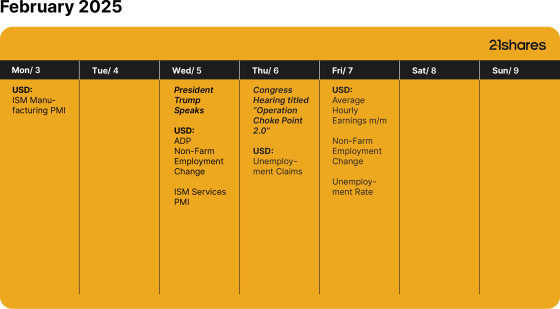
Research Newsletter
Each week the 21Shares Research team will publish our data-driven insights into the crypto asset world through this newsletter. Please direct any comments, questions, and words of feedback to research@21shares.com
Disclaimer
The information provided does not constitute a prospectus or other offering material and does not contain or constitute an offer to sell or a solicitation of any offer to buy securities in any jurisdiction. Some of the information published herein may contain forward-looking statements. Readers are cautioned that any such forward-looking statements are not guarantees of future performance and involve risks and uncertainties and that actual results may differ materially from those in the forward-looking statements as a result of various factors. The information contained herein may not be considered as economic, legal, tax or other advice and users are cautioned to base investment decisions or other decisions solely on the content hereof.
Du kanske gillar
-
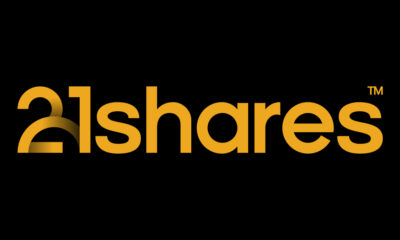

Why Bitcoin belongs in your portfolio
-
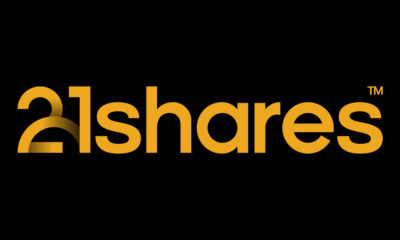

Thinking of buying your first Bitcoin? Read these 5 tips first
-
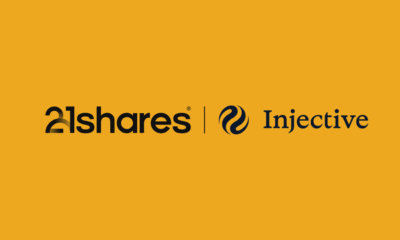

Primer: Injective, infrastructure for global finance
-


Bitcoin is resilient despite the Middle East war
-


Svenska investerare — 21Shares Nasdaq Stockholm-sortiment har just blivit starkare
-


UK looking to lift the retail ban on crypto ETPs
Nyheter
Defence and AI dominate as European Thematic ETF flows hit record $8.73 billion H1 2025
Publicerad
13 timmar sedanden
8 juli, 2025
• Top Performer: Defence (+$7.87 billion)
• Emerging Themes: Cybersecurity (+$318 million), Uranium (+$253 million)
European thematic UCITS ETFs posted a dramatic resurgence in the first half of 2025, with net inflows of $8.73 billion year-to-date, according to ARK Invest Europe’s latest quarterly update detailing H1 2025 European thematic ETF flows.
The turnaround marks a decisive reversal from the muted flows of 2024 ($308 million net outflows for the whole of 2024), as investors rotate back into forward-looking, innovation-driven themes with clearer earnings visibility.
Defence remains the dominant thematic allocation, capturing $7.87 billion in combined net inflows between Global ($4.81 billion) and European ($3.05 billion) defence ETFs underscoring its evolution from a tactical trade to a structural portfolio allocation. Maintaining its position as the defining technological theme, AI ETFs saw $904 million in net inflows, with investor appetite fuelled by relentless innovation in large language models, robotics, and autonomous systems.
In the same period, Cybersecurity ETFs continued to rebuild momentum after significant outflows in 2024 ($311 million net outflows for H1 2024), drawing $318 million, reflecting growing investor conviction in cybersecurity as a structural necessity amid rising digital threats.
Clean Energy ETFs saw outflows of $307 million. As policy momentum stalls in key markets, investors are increasingly selective within the energy transition space. Capital is rotating toward subsectors with clearer economic moats, such as nuclear and grid infrastructure. Supporting this sentiment, Uranium ETFs rank fifth at $253 million, reflecting growing investor interest in the nuclear sector as a potential solution to global energy needs.
Healthcare Innovation ETFs recorded net outflows of $279 million. The drawdown reveals investor caution around legacy biotech firms with uncertain drug pipelines and reimbursement risks. Interest is shifting toward AI-driven healthcare platforms offering faster innovation cycles and more scalable business models.
Electric Vehicles and Battery Tech ETFs saw net outflows of $203 million as investor enthusiasm cools amid subsidy rollbacks and plateauing EV demand in major markets. Persistent concerns around battery raw materials and production bottlenecks have further weighed on the theme.
Rahul Bhushan says, “After a cautious 2024, it’s evident that investors are re-engaging with innovation themes that offer clearer earnings visibility and resilience in an increasingly complex macro landscape. We’re seeing investor conviction in megatrends with structural tailwinds, particularly defence, AI, and energy security. Thematics are no longer just tactical bets, they’re core strategic exposures.”
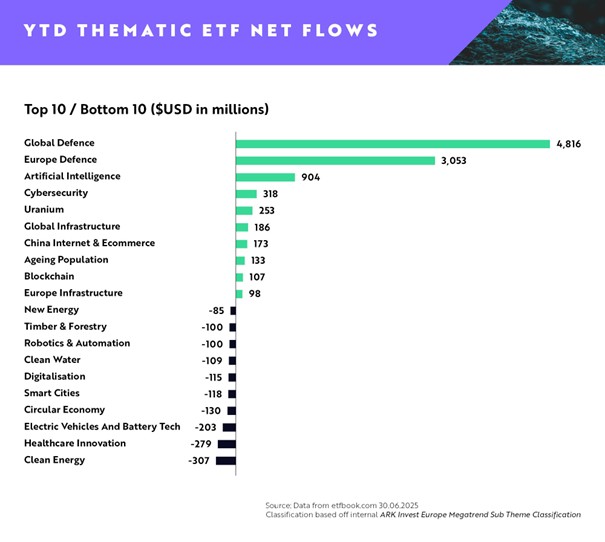
2025/2024 Comparative Study
Thematics are back
After a weak 2024, investor appetite for thematic risk has returned in force:
• H1 2025 total net inflows: +$8.74B
• That’s a sharp reversal from -$791M in H2 2024 and only +$483M in H1 2024
• The rotation is clear: capital is moving back into forward-looking themes with stronger earnings visibility.
Defence is now a structural trade
• Global and Europe Defence saw a combined $7.87B in inflows in H1 2025 and $1.59B in June alone.
• This continues a multi-quarter surge as geopolitical tensions, rising military budgets, and renewed industrial policy drive long-term allocations.
• Defence is no longer a tactical trade—it’s becoming a core exposure.
AI inflows normalise, but conviction remains
• Artificial Intelligence ETFs drew $904M in H1 2025, following $1.47B in H1 2024.
• Inflows may be slowing, but investor conviction is holding firm.
• With earnings delivery now catching up to narrative, AI remains a centrepiece of thematic portfolios.
Cybersecurity shows signs of stabilisation
After brutal outflows in 2024 (-$311M H1, -$260M H2), cybersecurity ETFs finally saw inflows:
• $318M in H1 2025, including $67M in June.
• This rebound suggests investors are once again prioritising digital resilience in an AI-driven world.
Infrastructure themes are quietly regaining traction
• Global and Europe Infrastructure ETFs pulled in $284M in H1 2025, following modest gains in H2 2024.
• Infrastructure is benefiting from government stimulus, defence modernisation, and the reshoring trade.
Uranium’s steady climb continues
• $253M in H1 2025, after $216M in H2 2024 and $67M in June alone.
• Indeed, the $67M in June alone nearly matches the $66M pulled in during the entirety of H1 2024.
• A rare clean energy theme that’s bucking the downtrend, reflecting growing recognition of nuclear as a pragmatic decarbonisation solution.
Clean Energy sentiment is so bad, it might be investable
• Outflows across all periods: -$307M (H1 2025), -$505M (H2 2024), -$409M (H1 2024)
• June 2025: A mere -$8M
• Sentiment is arguably as negative as it’s ever been—yet structural drivers remain in place. The setup for a contrarian rebound is building.
About ARK Invest Europe
ARK Invest International Ltd (”ARK Invest Europe”) is a specialist thematic ETF issuer offering investors access to a unique blend of active and index strategies focused on disruptive innovation and sustainability. Established following the acquisition of Rize ETF in September 2023 by ARK Investment Management LLC, ARK Invest Europe builds on over 40 years of expertise in identifying and investing in innovations that align financial performance with positive global impact.
Through its innovation pillar and the ”ARK” range of ETFs, ARK Invest focuses on companies leading and benefiting from transformative cross-sector innovations, including robotics, energy storage, multiomic sequencing, artificial intelligence, and blockchain technology. Meanwhile, its sustainability pillar, represented by the ”Rize by ARK Invest” range of ETFs, prioritises investment opportunities that reconcile growth with sustainability, advancing solutions that fuel prosperity while promoting environmental and social progress.
Headquartered in London, United Kingdom, ARK Invest Europe is dedicated to empowering investors with purposeful investment opportunities. For more information, please visit https://europe.ark-funds.com/
Nyheter
UBS Asset Management lanserar sin första aktivt förvaltade ETF
Publicerad
14 timmar sedanden
8 juli, 2025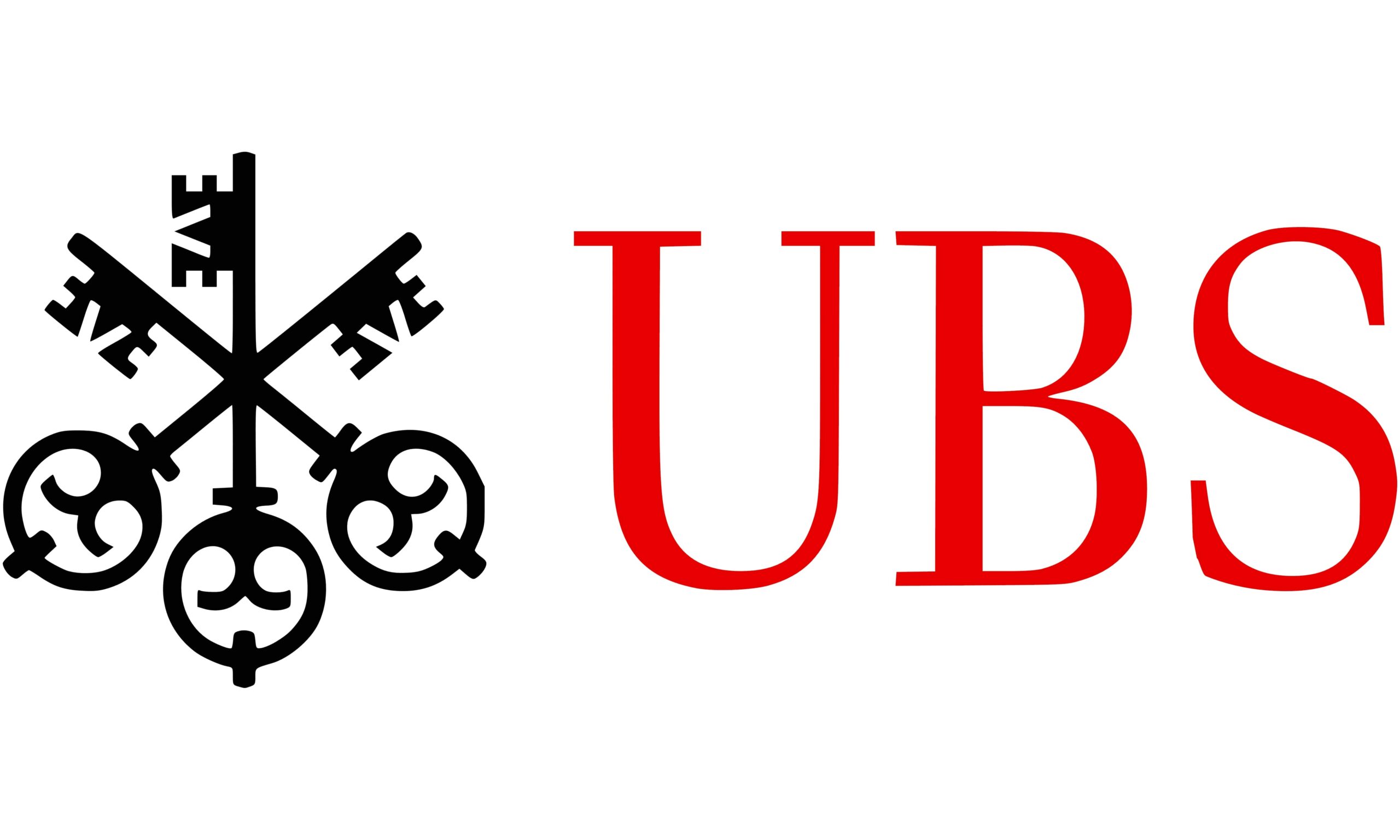
- UBS Asset Management planerar att erbjuda ett utbud av aktiva ETFer som utnyttjar deras differentierade räntebärande kapacitet, följt senare av en serie avkastningsfokuserade ETFer med optionsöverlägg.
- Den första som lanseras idag ger tillgång till den aktiva förvaltningsexpertisen hos UBS AMs Credit Investments Group (CIG), en av de ledande förvaltarna av collateralized loan obligations globalt.
- Den nya UBS EUR AAA CLO UCITS ETF erbjuder investerare exponering mot den högsta kreditkvaliteten inom CLO-strukturen i ett likvidt och kostnadseffektivt omslag.
UBS Asset Management (UBS AM) tillkännager idag lanseringen av sin första aktivt förvaltade ETF, som ger kostnadseffektiv exponering mot de högst rankade trancherna av marknaden för collateralized loan obligation (”CLO”). UBS EUR AAA CLO UCITS ETF kombinerar den aktiva förvaltningsexpertisen hos UBS AMs Credit Investments Group med skalan hos deras väletablerade ETF-erbjudande.
André Mueller, chef för kundtäckning på UBS Asset Management, sa: ”CLOer erbjuder stark avkastningspotential och diversifieringsfördelar. Att navigera på denna marknad kräver dock förståelse för CLO-strukturer, regleringar och riskerna i denna sektor. Vi har kombinerat mer än 20 års ETF-innovation med expertisen hos vår Credit Investments Group för att effektivt och transparent tillhandahålla de högst rankade CLO-värdepapperen. Den aktiva förvaltningsdelen erbjuder kostnadseffektiv exponering med potential att överträffa.”
John Popp, chef för Credit Investments Group på UBS Asset Management, tillade: ”Vi är glada att kunna erbjuda vår expertis inom hantering av CLO-trancher i över två decennier till en bredare investerarbas. Vårt teams djupa kreditkunskap och meritlista genom flera kreditcykler gör oss väl positionerade för att tillhandahålla övertygande investeringar. På dagens marknad anser vi att AAA CLO-skulder erbjuder en attraktiv risk-avkastningsprofil. Att erbjuda denna investering via en ETF kommer att utöka tillgången till denna växande marknad.”
Den aktiva UBS EUR AAA CLO UCITS ETF* erbjuder tillgång till den växande CLO-marknaden genom en likvid och kostnadseffektiv ETF-struktur, vilket innebär:
- Förbättrad avkastningspotential med strukturellt skydd – AAA CLOer erbjuder högre avkastning jämfört med liknande rankade investeringar, med strukturella egenskaper som har testats genom cykler, utan fallissemang ens under perioder av ekonomisk kris**
- Portföljdiversifiering – tillgångsslagets rörliga ränta ger betydande diversifieringspotential i samband med en bredare ränteportfölj
- Aktiv fördel – Credit Investments Group, en av de främsta förvaltarna av säkerställda låneförpliktelser globalt, hanterar dynamiskt risk och avkastning för att fånga marknadsmöjligheter
- ETF-effektivitet – ETF-strukturen möjliggör likviditet och kostnadseffektiv tillgång till denna komplexa tillgångsklass
*Fonden är registrerad för försäljning i Österrike, Schweiz, Tyskland, Danmark, Spanien, Finland, Frankrike, Irland, Italien, Liechtenstein, Luxemburg, Nederländerna, Norge och Sverige.
**S&P Global Ratings, “Default, Transition, and Recovery: 2023 Annual Global Leveraged Loan CLO Default and Rating Transition Study”, 27 juni 2024
Nyheter
AZEH ETF är en aktivt förvaltad ETF som investerar i Asien ex Japan
Publicerad
15 timmar sedanden
8 juli, 2025
iShares Asia ex Japan Equity Enhanced Active UCITS ETF USD (Acc) (AZEH ETF) med ISIN IE000D5R9C23, är en aktivt förvaltad ETF.
Den börshandlade fonden investerar minst 70 procent i aktier från Asien (exklusive Japan). Upp till 30 procent av tillgångarna kan placeras i private equity-instrument, värdepapper med fast ränta med investment grade-rating och penningmarknadsinstrument. Värdepapper väljs utifrån hållbarhetskriterier och en kvantitativ investeringsmodell.
Den börshandlade fondens TER (total cost ratio) uppgår till 0,30 % p.a. iShares Asia ex Japan Equity Enhanced Active UCITS ETF USD (Acc) är den enda ETF som följer iShares Asia ex Japan Equity Enhanced Active-index. ETFen replikerar det underliggande indexets prestanda genom fullständig replikering (köper alla indexbeståndsdelar). Utdelningarna i ETFen ackumuleras och återinvesteras.
iShares Asia ex Japan Equity Enhanced Active UCITS ETF USD (Acc) är en mycket liten ETF med 9 miljoner euro förvaltade tillgångar. ETFen lanserades den 31 juli 2024 och har sin hemvist i Irland.
Investeringsmål
Fonden förvaltas aktivt och syftar till att uppnå långsiktig kapitaltillväxt på din investering, med hänvisning till MSCI AC Asia ex Japan Index (”Riktmärket”) för avkastning.
Handla AZEH ETF
iShares Asia ex Japan Equity Enhanced Active UCITS ETF USD (Acc) (AZEH ETF) är en europeisk börshandlad fond. Denna fond handlas på flera olika börser, till exempel Deutsche Boerse Xetra och London Stock Exchange.
Det betyder att det går att handla andelar i denna ETF genom de flesta svenska banker och Internetmäklare, till exempel DEGIRO, Nordnet, Aktieinvest och Avanza.
Börsnoteringar
Största innehav
| Kortnamn | Namn | Sektor | Vikt (%) | ISIN | Valuta |
| USD | USD CASH | Cash and/or Derivatives | 12.85 | – | USD |
| ISTUSAD | BLK ICS US TREAS AGENCY DIS | Cash and/or Derivatives | 9.01 | IE00B3YQRB45 | USD |
| 2330 | TAIWAN SEMICONDUCTOR MANUFACTURING | Informationsteknologi | 8.55 | TW0002330008 | TWD |
| 700 | TENCENT HOLDINGS LTD | Kommunikationstjänster | 5.58 | KYG875721634 | HKD |
| 005930 | SAMSUNG ELECTRONICS LTD | Informationsteknologi | 4.40 | KR7005930003 | KRW |
| 9988 | ALIBABA GROUP HOLDING LTD | Sällanköpsvaror | 2.50 | KYG017191142 | HKD |
| GSIFT | CASH COLLATERAL USD GSIFT | Cash and/or Derivatives | 2.02 | – | USD |
| 1299 | AIA GROUP LTD | Finans | 1.99 | HK0000069689 | HKD |
| 000660 | SK HYNIX INC | Informationsteknologi | 1.27 | KR7000660001 | KRW |
| PDD | PDD HOLDINGS ADS INC | Sällanköpsvaror | 1.27 | US7223041028 | USD |
Innehav kan komma att förändras

Defence and AI dominate as European Thematic ETF flows hit record $8.73 billion H1 2025

UBS Asset Management lanserar sin första aktivt förvaltade ETF

AZEH ETF är en aktivt förvaltad ETF som investerar i Asien ex Japan

Regan Capital debuterar i Europa med aktivt förvaltad totalavkastande inkomst-ETF

EUPD ETF köper aktier i undervärderade sektorer i USA

De bästa ETFer som investerar i europeiska utdelningsaktier

YieldMax® lanserar sin andra produkt för europeiska investerare

Big News for Nuclear Energy—What It Means for Investors

Svenska investerare — 21Shares Nasdaq Stockholm-sortiment har just blivit starkare

3EDS ETN ger tre gånger den negativa avkastningen på flyg- och försvarsindustrin
Populära
-

 Nyheter2 veckor sedan
Nyheter2 veckor sedanDe bästa ETFer som investerar i europeiska utdelningsaktier
-
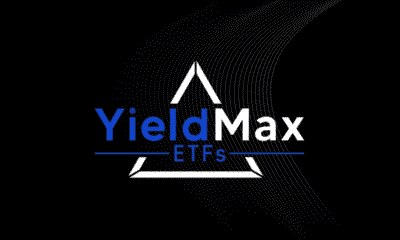
 Nyheter4 veckor sedan
Nyheter4 veckor sedanYieldMax® lanserar sin andra produkt för europeiska investerare
-
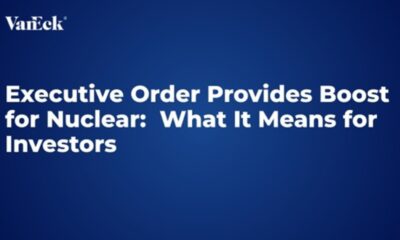
 Nyheter4 veckor sedan
Nyheter4 veckor sedanBig News for Nuclear Energy—What It Means for Investors
-

 Nyheter2 veckor sedan
Nyheter2 veckor sedanSvenska investerare — 21Shares Nasdaq Stockholm-sortiment har just blivit starkare
-

 Nyheter4 veckor sedan
Nyheter4 veckor sedan3EDS ETN ger tre gånger den negativa avkastningen på flyg- och försvarsindustrin
-
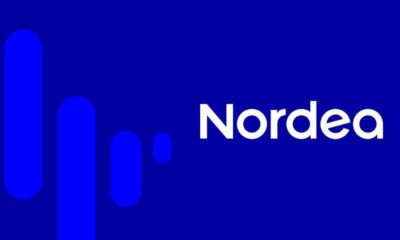
 Nyheter2 veckor sedan
Nyheter2 veckor sedanNordea Asset Management lanserar nya ETFer på Xetra
-

 Nyheter1 vecka sedan
Nyheter1 vecka sedanHetaste investeringstemat i juni 2025
-
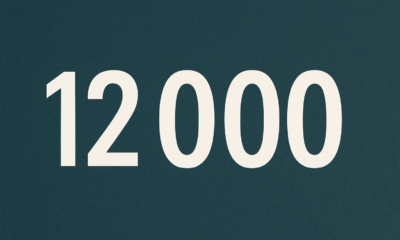
 Nyheter1 vecka sedan
Nyheter1 vecka sedan12 000 artiklar om börshandlade fonder


